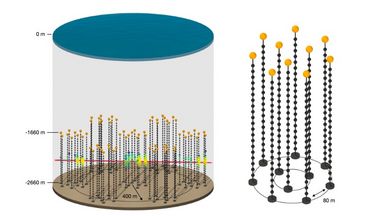Route to P-ONE
The Pacific Ocean Neutrino Experiment (P-ONE) is a proposed large-volume neutrino telescope in the Northeast Pacific Ocean, off the coast of Vancouver Island, Canada. With more than one cubic kilometer of instrumented deep sea volume, P-ONE will target measuring high-energy neutrinos to shed light on the nature of astrophysical accelerators and the cosmos.
With low expected scattering in the deep ocean, water-based detectors theoretically allow for sub-degree event resolution but carry various challenges. With changing ocean currents and abundant organic matter, the detector geometry, water optical properties, and bioluminescent light background vary with time.
This dynamic environment of the deep ocean requires rugged detector technologies and multiple precise calibration and monitoring systems to enable and maintain the detector’s full scientific potential. In cooperation with Ocean Networks Canada (ONC), the P-ONE collaboration aims to deploy a detector with a target lifetime of 25 years.
2018 - 2023: Investigation of the site with the STRAW experiments
In preparation of the design concept, the site has been thoroughly investigated with two pathfinder missions: STRings for Absorption length in Water (STRAW) and STRAW-B, installed by ONC at the Cascadia Basin site in 2018 and 2020. These missions verified the suitable optical properties and backgrounds of the Cascadia Basin deep sea and the reliability of ONC operations.
The vision for P-ONE is to install more than 70 instrumented mooring lines (or strings), each 1 km in length. The strings will be equipped with 20 optical detection modules each, which are evenly spread along the entire length of the mooring. It is further envisioned that they are deployed in groups or clusters, providing a segmented geometry. Combined with low scattering in the deep-sea water of the Pacific Ocean, this will allow exceptional directional reconstruction of neutrino events, especially horizontal tracks. Furthermore, it will reduce the risk and complexity of necessary deep-sea operations.
2025: Deployment of the first prototype line of P-ONE
The development of the P-ONE prototype line, P-ONE-1, is ongoing, with planned deployment in 2025.
2025 - 2030: Completion of the P-ONE Demonstrator
The P-ONE Demonstrator will be the first cluster of the P-ONE detector, comprised of ten instrumented mooring lines and connected to the ONC deep sea network.

